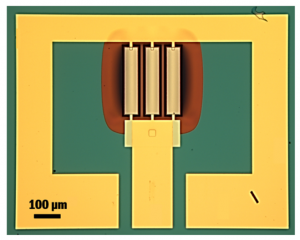Goal: Revolutionizing the way we wirelessly transmit power to untethered devices
Since the harvested power is scarce for ultra-small receiver (Rx) coils, power losses at every stage of the design process must be minimized. We have designed novel design procedures for 2-coil wireless links to maximize the wireless power transfer efficiency. In the current IMD prototype, an on-chip coil is used to capture RF energy transmitted by an external coil fabricated on PCB. Both coils have been highly optimized, leading to a total system efficiency of 0.002% in tissue for a Tx-Rx distance of 6.6 mm. This resulted in one of the highest inductive power links to date for ultra-small receivers (< 500µm).
 |
 |

On-going work:
- We plan on using a novel acoustically actuated magnetoelectric (ME) antenna which currently shows the highest power transfer efficiency reported to date compared to other receivers of similar dimensions. We have recently shown that ME antennas do not suffer from the same miniaturization constraints as coils or piezo transformers and they can be driven by weak magnetic fields. Although we have developed and characterized a working miniaturized ME antenna prototype, a lot of challenges remain (e.g., encapsulation and integration onto an IMD, characterization in animal models) which we plan to address in the coming years.
- We plan on developing a network of miniaturized wirelessly powered implants (for interfacing the brain, spinal cord, retina, and the vagus nerve) that communicate with the cloud to enable the development of the Internet of Bodies (IoB). The main challenge of this work is the fabrication of an ultra-small Magnetoelectric Antenna or Coil that can be used to harvest wireless energy and provide high data rate communication.